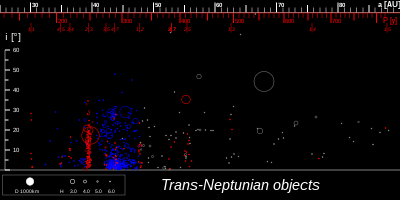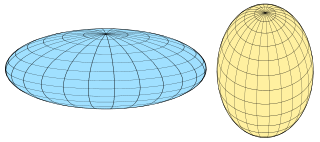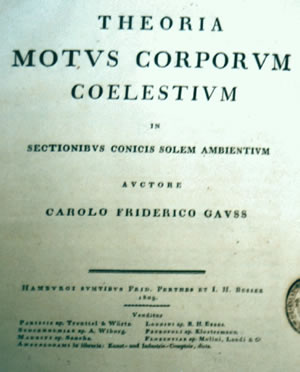Criteria
The phrase refers to an orbiting body (a planet or protoplanet) "sweeping out" its orbital region over time, by gravitationally interacting with smaller bodies nearby. Over many orbital cycles, a large body will tend to cause small bodies either to accrete with it, or to be disturbed to another orbit, or to be captured either as a satellite or into a resonant orbit. As a consequence it does not then share its orbital region with other bodies of significant size, except for its own satellites, or other bodies governed by its own gravitational influence. This latter restriction excludes objects whose orbits may cross but that will never collide with each other due to orbital resonance, such as Jupiter and its trojans, Earth and 3753 Cruithne, or Neptune and the plutinos. [3] As to the extent of orbit clearing required, Jean-Luc Margot emphasises "a planet can never completely clear its orbital zone, because gravitational and radiative forces continually perturb the orbits of asteroids and comets into planet-crossing orbits" and states that the IAU did not intend the impossible standard of impeccable orbit clearing. [2]
Stern–Levison's Λ
In their paper, Stern and Levison sought an algorithm to determine which "planetary bodies control the region surrounding them". [3] They defined Λ (lambda), a measure of a body's ability to scatter smaller masses out of its orbital region over a period of time equal to the age of the Universe (Hubble time). Λ is a dimensionless number defined as
where m is the mass of the body, a is the body's semi-major axis, and k is a function of the orbital elements of the small body being scattered and the degree to which it must be scattered. In the domain of the solar planetary disc, there is little variation in the average values of k for small bodies at a particular distance from the Sun. [4]
If Λ > 1, then the body will likely clear out the small bodies in its orbital zone. Stern and Levison used this discriminant to separate the gravitationally rounded, Sun-orbiting bodies into überplanets, which are "dynamically important enough to have cleared [their] neighboring planetesimals", and unterplanets. The überplanets are the eight most massive solar orbiters (i.e. the IAU planets), and the unterplanets are the rest (i.e. the IAU dwarf planets).
Soter's μ
Steven Soter proposed an observationally based measure μ (mu), which he called the "planetary discriminant", to separate bodies orbiting stars into planets and non-planets. [4] He defines mu as
where μ is a dimensionless parameter, M is the mass of the candidate planet, and m is the mass of all other bodies that share an orbital zone, that is all bodies whose orbits cross a common radial distance from the primary, and whose non-resonant periods differ by less than an order of magnitude. [4]
The order-of-magnitude similarity in period requirement excludes comets from the calculation, but the combined mass of the comets turns out to be negligible compared with the other small Solar System bodies, so their inclusion would have little impact on the results. μ is then calculated by dividing the mass of the candidate body by the total mass of the other objects that share its orbital zone. It is a measure of the actual degree of cleanliness of the orbital zone. Soter proposed that if μ > 100, then the candidate body be regarded as a planet. [4]
Margot's Π
Astronomer Jean-Luc Margot has proposed a discriminant, Π (pi), that can categorise a body based only on its own mass, its semi-major axis, and its star's mass. [2] Like Stern–Levison's Λ, Π is a measure of the ability of the body to clear its orbit, but unlike Λ, it is solely based on theory and does not use empirical data from the Solar System. Π is based on properties that are feasibly determinable even for exoplanetary bodies, unlike Soter's μ, which requires an accurate census of the orbital zone.
where m is the mass of the candidate body in Earth masses, a is its semi-major axis in AU, M is the mass of the parent star in solar masses, and k is a constant chosen so that Π > 1 for a body that can clear its orbital zone. k depends on the extent of clearing desired and the time required to do so. Margot selected an extent of times the Hill radius and a time limit of the parent star's lifetime on the main sequence (which is a function of the mass of the star). Then, in the mentioned units and a main-sequence lifetime of 10 billion years, k = 807. [lower-alpha 1] The body is a planet if Π > 1. The minimum mass necessary to clear the given orbit is given when Π = 1.
Π is based on a calculation of the number of orbits required for the candidate body to impart enough energy to a small body in a nearby orbit such that the smaller body is cleared out of the desired orbital extent. This is unlike Λ, which uses an average of the clearing times required for a sample of asteroids in the asteroid belt, and is thus biased to that region of the Solar System. Π's use of the main-sequence lifetime means that the body will eventually clear an orbit around the star; Λ's use of a Hubble time means that the star might disrupt its planetary system (e.g. by going nova) before the object is actually able to clear its orbit.
The formula for Π assumes a circular orbit. Its adaptation to elliptical orbits is left for future work, but Margot expects it to be the same as that of a circular orbit to within an order of magnitude.






























